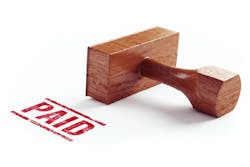It’s seemingly trickier than ever for collision centers to get properly reimbursed by insurers for work, especially as industry technology evolves. And consider this prediction, provided by Tim Ronak, senior services consultant with AkzoNobel:
As vehicle technology continues to change, dealerships’ training budgets are likely to at least triple over the next three years.
Additionally, in order to be reimbursed properly, your department first has to know and consider business costs such as overhead, staff wages, energy costs, and marketing, Ronak notes. Understanding those costs and how they affect labor is crucial before deciding how much you should be reimbursed.
“You add all those things up, and the impact on what you should have as a reimbursed hourly charge, it’s pretty dramatic,” says Ronak, who ran a GM dealership in Canada earlier in his career.
How can you ensure that you’re getting paid by insurers what you’re worth? That comes down to knowledge, documentation and your ability to provide proof of your area’s fair market rate, Ronak notes.
Note how training budgets impact labor.
It’s an insurer’s obligation to reimburse the customer for what it costs to complete a repair. But insurers often feel confident that they can get repair work done elsewhere for a cheaper price, if necessary, Ronak says. And that creates friction for collision centers in trying to get reimbursed for work.
One persistent problem for dealership body shops is knowing—and, as a result, proving—their true training cost. Understanding how your training budget impacts labor is imperative when determining what your reimbursement rate will be.
Consider the following example posed by Ronak: There are approximately 2,000 hours per year available for each of your technicians, and, even if your facility has impeccable efficiency, that creates roughly 3,000 billable units per technician. So, if you spend $9,000 in annual training for that employee, that creates an additional $3 per hour that will be pulled from your profits and for which needs to be accounted.
Document thoroughly.
In order to get paid for work—be it pre- and post-repair scanning, proper repair procedures or using OEM parts—documentation is imperative.
Ronak suggests taking photographs, if necessary, to show the physical differences between a suggested aftermarket part and an OE part. It’s a step worth taking, considering that failing to return a vehicle to its pre-loss condition can leave you, as the repairer, potentially at risk.
“Documentation is absolutely the key,” Ronak says.
When it comes to noting required repair procedures, Ronak points out that your department could use a resource like oem1stop.com, which provides access to all OEM procedures for all manufacturers.
Observe your competition.
Ronak has a simple solution for helping your department prove the fair market rate in your area: mystery shop your competition. In other words, take note of what your rivals are charging for repair work.
“Be armed, from a point of knowledge, about what the competition charges,” Ronak says. “You need to be competitive in your local market. And insurers, unless you signed a rather punitive contract with one of them, are obligated to pay all the costs of a repair at a reasonable retail price, which is determined by analyzing what the competition in your surrounding area charges at retail, while considering your costs of providing that repair.”

